When the second collaborative ORNL-Vanderbilt University workshop took place on Sept. 18-19 at ORNL, about 70 researchers and students assembled to share thoughts concerning a broad spectrum of topics.
Filter News
Related Organization
- (-) Materials Theory Group (7)
- (-) Reflectometry Group (2)
- Advanced Computing for Chemistry and Materials Group (1)
- Advanced Computing for Nuclear, Particles, and Astrophysics Group (1)
- Advanced Computing in Health Sciences Section (2)
- Advanced Computing Methods for Engineered Systems Section (4)
- Advanced Computing Methods for Physical Sciences Section (11)
- Advanced Computing Systems Research Section (6)
- Advanced Fibers Manufacturing Group (1)
- Advanced Manufacturing and Industrial Decarbonization Programs (3)
- Advanced Nuclear Materials Group (7)
- Advanced Reactor Engineering and Development Section (3)
- Advanced Technologies Section (3)
- Algorithms and Performance Analysis Group (1)
- Alloy Behavior and Design Group (7)
- Analytics and AI Methods at Scale Group (1)
- Applied Catalysis and Emissions Controls Research Group (1)
- Artificial Intelligence (AI) Initiative (1)
- Autonomous and Complex Systems Group (1)
- Behavior and Design Group (2)
- Bethel Valley Radiochemical Processing Group (1)
- Beyond Moore Group (2)
- Bioanalytical Mass Spectrometry Group (8)
- Biocomputing and Information Section (2)
- Biodesign and Systems Biology Section (2)
- Biodiversity and Ecosystem Health Group (1)
- Biodiversity and Sustainable Systems Section (3)
- Bioimaging and Analytics Section (9)
- Biological and Environmental Systems Science Directorate (27)
- Biological Labeling and Scattering Group (1)
- Biomaterials and Biomass Characterization Group (1)
- Bioresource Science and Engineering Group (1)
- Biosciences Division (20)
- Biostatistics and Biomedical Informatics Group (1)
- Blanket and Fuel Cycle Group (1)
- Building Envelope Materials Research Group (3)
- Building Equipment Research Group (2)
- Buildings and Transportation Science Division (11)
- Building Technologies Program (1)
- Building Technologies Research and Integration Center (2)
- Building Technologies Research Section (7)
- Carbon and Composites Group (9)
- Carbon Fiber Technology Facility (2)
- Center for Bioenergy Innovation (3)
- Center for Nanophase Materials Sciences (127)
- Center for Structural Molecular Biology (2)
- Chemical and Isotopic Mass Spectrometry Group (1)
- Chemical Process Scale-Up Group (7)
- Chemical Sciences, Geosciences, and Biosciences (3)
- Chemical Sciences Division (141)
- Chemical Separations Group (18)
- Chemical Spectroscopy Group (2)
- Chemical Transformations Section (20)
- Climate Change Science Institute (2)
- Communications Directorate (3)
- Community Outreach Group (1)
- Compensation and HRIS (1)
- Composite Science and Technology Section (10)
- Composites Innovation Group (5)
- Computational and Applied Mathematics Group (1)
- Computational Chemical and Materials Science Group (2)
- Computational Chemistry and Nanomaterials Sciences Group (6)
- Computational Earth Sciences Group (2)
- Computational Sciences and Engineering Division (35)
- Computational Systems Engineering and Cybernetics Group (1)
- Computer Science and Mathematics Division (21)
- Computing and Computational Sciences Directorate (62)
- Cooling Systems Group (1)
- Correlated Electron Materials Group (15)
- Corrosion Science and Technology Group (8)
- Creative Services Group (2)
- Cyber Resilience and Intelligence Division (3)
- Data Analysis and Machine Learning Group (6)
- Data and AI Systems Section (3)
- Data Lifecycle and Scalable Workflows Group (1)
- Data NanoAnalytics Group (7)
- Data Science and Visualization (1)
- Data System Sciences and Engineering Group (1)
- Deposition Science and Technology Group (4)
- Diffraction Section (2)
- Direct Geometry Group (2)
- Disruptive Manufacturing Systems Development (4)
- Earth Systems Science Section (4)
- Ecosystem Processes Group (1)
- Electric Drives Research Group (2)
- Electrification and Energy Infrastructures Division (16)
- Electrification Section (12)
- electron Microscopy and Microanalysis Group (4)
- Embedded Systems Security Group (1)
- Emerging and Solid-State Batteries Group (3)
- Energy and Control Systems Security Group (2)
- Energy and Industrial Decarbonization Section (5)
- Energy Science and Technology Directorate (64)
- Energy Sensing, Analytics and Communications Section (1)
- Energy Storage and Conversion Group (20)
- Energy Storage and Conversion Manufacturing Group (9)
- Energy Systems Development Group (2)
- Energy Systems Integration and Controls Section (2)
- Environmental Sciences Division (10)
- Facilities and Operations Directorate (4)
- Foundational Materials Science Section (24)
- Fuel Cycle Chemical Technology Group (3)
- Fuel Science and Engine Technologies Research Group (1)
- Functional Atomic Force Microscopy Group (4)
- Fundamental Nuclear and Particle Physics Section (11)
- Fundamental Symmetries (2)
- Fusion and Fission Energy and Science Directorate (21)
- Fusion Energy Division (6)
- Fusion Nuclear Science, Technology, and Engineering Section (1)
- Geochemistry and Interfacial Science Group (10)
- GIST (1)
- HFIR Beamline Operations Section (1)
- HFIR Science Support Group (1)
- High Flux Isotope Reactor (12)
- HPC Methods for Nuclear Applications Group (1)
- HPC Operations Section (3)
- HPC Scalable Systems Group (1)
- HPC Systems Section (2)
- Human Resources Directorate (2)
- Information Systems Group (1)
- Innovation Crossroads (3)
- Integrated Building Deployment and Analysis (1)
- Integrated Fuel Cycle Section (3)
- Integrated Operations Support Division (2)
- Intelligent Systems and Facilities Group (2)
- Isotope Applications Research Group (2)
- Isotope Science and Enrichment Directorate (13)
- Labs and Soft Matter Group (1)
- Large Scale Structures Section (8)
- Learning Systems Group (1)
- Low Energy Nuclear Physics Experimental Program (3)
- Macromolecular Nanomaterials Group (3)
- Manufacturing Demonstration Facility (8)
- Manufacturing Energy Efficiency Research and Analysis Group (2)
- Manufacturing Science Division (23)
- Manufacturing Systems Analytics Group (1)
- Mass Spectrometry and Laser Spectroscopy Group (7)
- Materials and Chemistry Group (9)
- Materials Characterization and Modeling (1)
- Materials Engineering Group (4)
- Materials for Advanced Manufacturing Group (1)
- Materials in Extremes Section (25)
- Materials Joining Group (3)
- Materials Science and Technology Division (147)
- Materials Sciences and Engineering Program (20)
- Materials Structure and Processing Science Section (16)
- Materials Theory, Modeling and Simulation Section (16)
- Mathematics in Computation Section (5)
- Mechanical Properties and Mechanics Group (7)
- Metals and Composites Processing Group (2)
- Microbial Ecology and Physiology Group (1)
- Microstructural Evolution Modeling Group (9)
- Molecular and Cellular Imaging Group (3)
- Molecular Biophysics Group (1)
- Multifunctional Equipment Integration Group (5)
- Multiphysics CFD Applications Group (1)
- Multiphysics Modeling and Flows Group (3)
- Multiscale Materials Group (2)
- Multiscale Methods and Dynamics Group (1)
- Nanofabrication Research Laboratory Group (14)
- Nanomaterials Characterization Section (21)
- Nanomaterials Chemistry Group (25)
- Nanomaterials Synthesis Section (7)
- Nanomaterials Theory Institute Group (8)
- National Center for Computational Sciences (6)
- National Center for Computational Sciences Oak Ridge Leadership Computing Facility (1)
- National Institute for Computational Sciences (3)
- National Security Sciences Directorate (8)
- National Transportation Research Center (3)
- Neutrinos Research Group (6)
- Neutron and X-Ray Scattering Group (8)
- Neutronics Group (1)
- Neutron Instrument Technologies (RP) Section (1)
- Neutron Scattering Division (32)
- Neutron Sciences Directorate (59)
- Neutron Symmetries Group (5)
- Neutron Technologies Division (2)
- Nuclear Analytical Chemistry Section (1)
- Nuclear Energy and Fuel Cycle Division (6)
- Nuclear Energy Materials Microanalysis (5)
- Nuclear Modeling and Simulation Development and Deployment Section (1)
- Nuclear Nonproliferation Division (3)
- Nuclear Science and Advanced Technology Section (13)
- Nuclear Structural Materials Group (2)
- Nuclear Structure and Nuclear Astrophysics Group (10)
- Oak Ridge Leadership Computing Facility (10)
- Office of the Laboratory Director (2)
- Partnerships (23)
- Physical Sciences Directorate (376)
- Physics Division (39)
- Plant - Soil Interactions Group (2)
- Plant Systems Biology Group (2)
- Powder Diffraction Group (2)
- Power Systems Resilience Group (2)
- Precision Manufacturing and Manufacturing Innovation (4)
- Programming Systems Group (1)
- Propulsion Science Section (3)
- Quantum Communications and Networking Group (1)
- Quantum Computational Science Group (2)
- Quantum Heterostructures Group (14)
- Quantum Information Science Group (3)
- Quantum Information Science Section (2)
- Quantum Science Center (1)
- Radiation Effects and Microstructural Analysis Group (5)
- Radiation Imaging and Advanced Diagnostics Group (5)
- Radioisotope Production Engineering and Analysis Section (1)
- Radioisotope Research and Development Section (4)
- Radioisotope Science and Technology Division (8)
- Relativistic Nuclear Physics Group (2)
- Research Accelerator Division (2)
- Research Reactors Division (2)
- Resilient Cyber-Physical Systems Section (2)
- Sample Environment and Labs Section (1)
- SANS and Spin Echo Group (3)
- Scanning Transmission Electron Microscopy Group (14)
- Scanning Tunneling Microscopy Group (3)
- Scattering and Thermophysics Group (7)
- Science Engagement Section (4)
- Second Target Station Division (1)
- Secure and Digital Manufacturing Section (3)
- Sensors and Electronics Group (4)
- Separations and Polymer Chemistry Section (51)
- Soft Matter Group (21)
- Spallation Neutron Source (28)
- Spectroscopy Section (4)
- Strategic Partnerships (2)
- Surface Chemistry and Catalysis Group (6)
- Surface Engineering and Tribology (3)
- Sustainable Manufacturing Technologies Group (4)
- System Acceptance and User Environment Group (2)
- System Automation and Monitoring Research (1)
- Target and Mechanical Systems Section (1)
- Target Design, Analysis, and Qualification Group (1)
- Technology Integration Group (1)
- Technology Transfer (19)
- Theoretical and Computational Physics Group (5)
- Theory and Computation Section (14)
- Thermal Energy Storage Research Group (1)
- Transportation (2)
- User Facilities (88)
- Vehicle and Mobility Systems Research Section (1)
- VISTA Laboratory (2)
- Water Resource Science and Engineering Group (1)
- Workflow Systems Group (1)
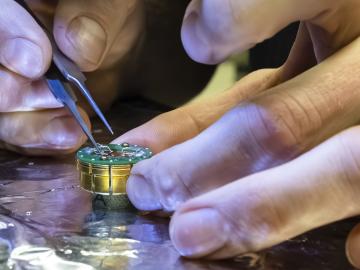
Quantum computers process information using quantum bits, or qubits, based on fragile, short-lived quantum mechanical states.
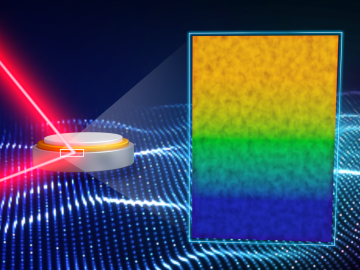
Researchers at the Department of Energy’s Oak Ridge National Laboratory were the first to use neutron reflectometry to peer inside a working solid-state battery and monitor its electrochemistry.
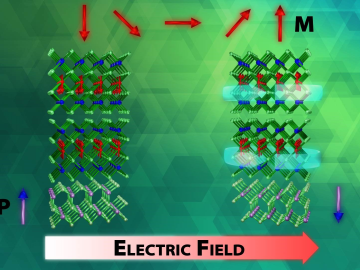
An advance in a topological insulator material — whose interior behaves like an electrical insulator but whose surface behaves like a conductor — could revolutionize the fields of next-generation electronics and quantum computing, according to scientist
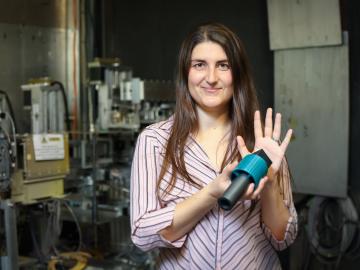
To solve a long-standing puzzle about how long a neutron can “live” outside an atomic nucleus, physicists entertained a wild but testable theory positing the existence of a right-handed version of our left-handed universe.

Neuromorphic devices — which emulate the decision-making processes of the human brain — show great promise for solving pressing scientific problems, but building physical systems to realize this potential presents researchers with a significant
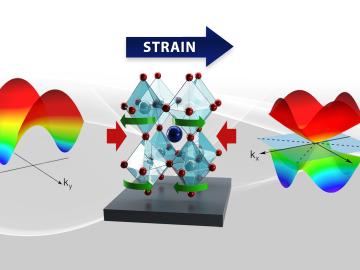
A team led by the ORNL has found a rare quantum material in which electrons move in coordinated ways, essentially “dancing.”
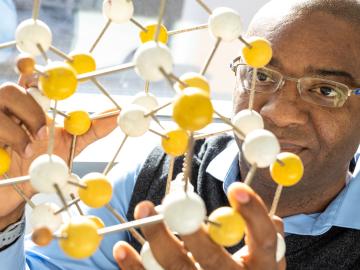
Valentino (“Tino”) Cooper of the Department of Energy’s Oak Ridge National Laboratory uses theory, modeling and computation to improve fundamental understanding of advanced materials for next-generation energy and information technologies.


